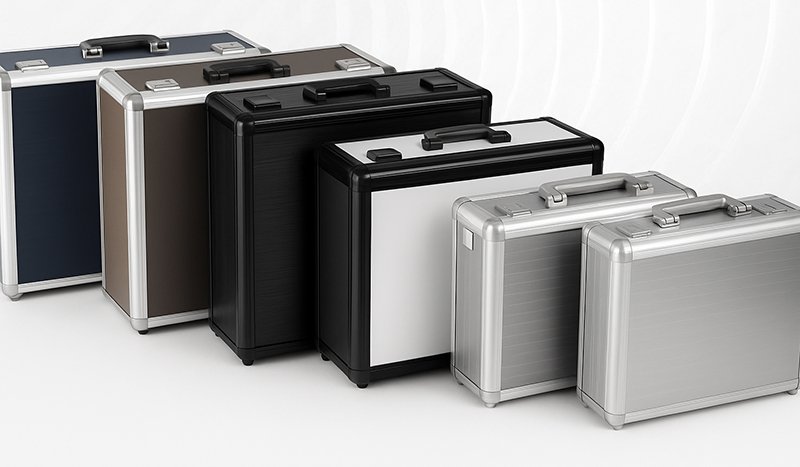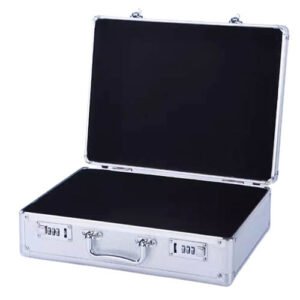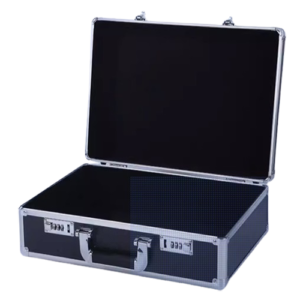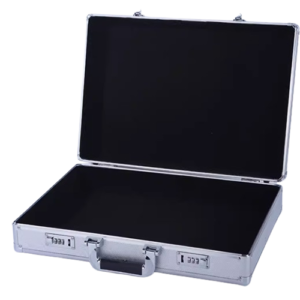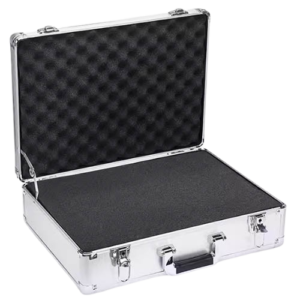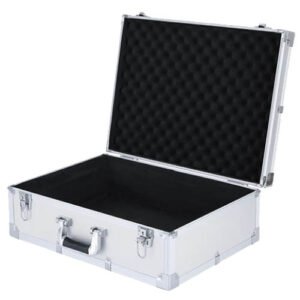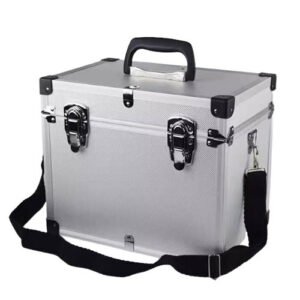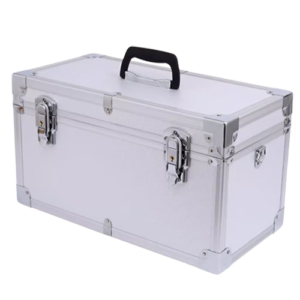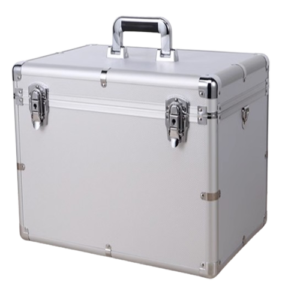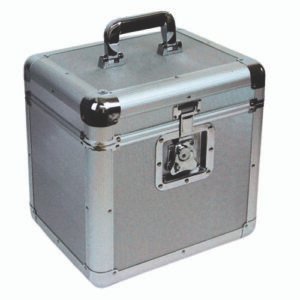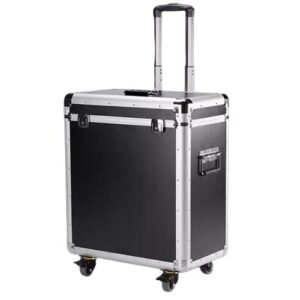Aluminium briefcasE
Lightweight cases for travel and protective storage.
-
TH21
HKD480.00 Select optionsAluminium instrument case
Size: 460x230x250H mm
Other available size:
500x300x300H mm -
THC11
HKD1,220.00 Select optionsAluminium trolley case
Size: 500x300x580H mm
Other available sizes:
560x360x580H mm
560x360x660H mm
Free Delivery
Guarantee prompt delivery
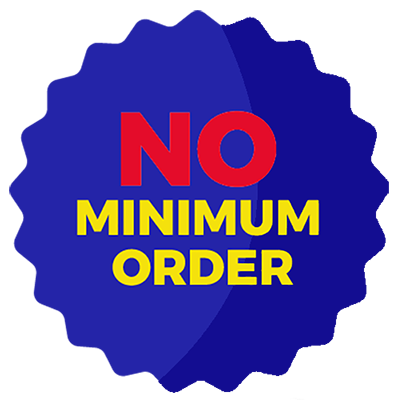
No Min. Order
Competitive prices
Free Design Services
Diverse Design Choices
Selection Criteria for Aluminium Briefcases
Aluminium briefcases have long been associated with professionalism, durability, and style. They are frequently used by business professionals, engineers, medical practitioners, and even security personnel who require a secure and reliable carrying solution. Unlike soft-sided cases or plastic alternatives, aluminium briefcases offer a combination of lightweight construction, rigidity, and aesthetic appeal. However, choosing the right aluminium briefcase involves more than simply picking one off the shelf. Buyers need to consider a wide range of factors to ensure the case meets their functional, professional, and long-term needs.
This document outlines the primary selection criteria to guide decision-makers in evaluating aluminium briefcases effectively. The analysis is structured into several key dimensions: material and construction quality, durability, weight, size and capacity, design and ergonomics, security features, portability, customization options, cost considerations, brand reputation, and sustainability.
1. Material and Construction Quality
The foundation of any aluminium briefcase lies in the materials used and the craftsmanship of its assembly. Aluminium as a metal is valued for its strength-to-weight ratio, corrosion resistance, and sleek finish. However, not all aluminium cases are created equal.
-
Aluminium Grade:
High-quality cases often use aircraft-grade aluminium alloys (e.g., 6061 or 5052), which provide superior rigidity and dent resistance while remaining lightweight. Lower-grade aluminium may save costs but risks warping or denting more easily. -
Wall Thickness:
The thickness of the aluminium sheet contributes directly to protection. For professional use, wall thickness of 1–2 mm is generally suitable. Thicker walls increase protection but add weight. -
Frame Construction:
Many aluminium cases employ reinforced corner caps, internal steel or aluminium frames, and extrusion profiles. Buyers should examine the robustness of corner joints and the alignment of panels, as weak construction may reduce longevity. -
Surface Finish:
Options include brushed aluminium, anodized coatings, or powder-coated finishes. A high-quality finish not only enhances appearance but also improves scratch and corrosion resistance.
2. Durability and Resistance
One of the main reasons professionals select aluminium over fabric or plastic is durability. A good briefcase should withstand daily handling, environmental exposure, and occasional impact.
-
Impact Resistance:
Aluminium is naturally rigid, but buyers should confirm whether the briefcase passes drop tests or has protective reinforcements in sensitive areas. -
Scratch Resistance:
Cases with anodized or powder-coated surfaces offer better scratch protection than plain polished aluminium. -
Weather and Corrosion Resistance:
Aluminium is inherently corrosion-resistant, but exposure to harsh environments (humidity, chemicals, or salt air) can accelerate wear. A sealed or anodized surface is essential for long-term protection. -
Hinge and Handle Strength:
Hinges and handles are high-stress components. Stainless steel or reinforced alloy hardware ensures the case does not fail under load.
3. Weight Considerations
Although aluminium is lighter than steel, briefcases still vary significantly in weight depending on size, thickness, and design.
-
Balance Between Weight and Protection:
Lightweight cases are easier to carry but may sacrifice rigidity. Heavier-duty versions provide better protection for fragile equipment but may cause fatigue during travel. -
Recommended Range:
Standard aluminium briefcases typically weigh between 2–5 kg when empty. Buyers should align weight preference with intended use: business professionals may prefer lighter models, while engineers transporting tools may accept extra weight for added robustness.
4. Size and Capacity
Size and storage capacity directly affect usability. Selecting the wrong dimensions can either restrict usability or add unnecessary bulk.
-
Standard Dimensions:
Typical briefcases measure between 16–18 inches in width, 12–14 inches in height, and 4–6 inches in depth. -
Internal Layout:
Cases designed for documents often include organized compartments, dividers, and pen holders. Tool-specific cases may use foam inserts, customizable slots, or modular trays. -
Laptop and Electronics Storage:
Professionals who carry laptops or tablets should ensure padded compartments are included. A briefcase should accommodate at least a 15–16-inch laptop for general compatibility. -
Expandable Capacity:
Some designs allow expansion or modular inserts for flexible use. This is advantageous when carrying both paperwork and electronic devices.
5. Design and Ergonomics
Beyond structural performance, design plays a critical role in everyday convenience and professional image.
-
Aesthetic Appeal:
Sleek, brushed aluminium or matte finishes project a modern and professional image. For executives, appearance may weigh almost as heavily as function. -
Internal Organization:
High-quality cases feature well-planned compartments:-
Document sleeves
-
Business card slots
-
Pen loops
-
Zippered pockets for accessories
-
-
Ergonomic Handling:
Handles should be padded, contoured, and firmly fixed. Sharp edges or poorly designed grips reduce comfort during prolonged carrying. -
Opening Mechanism:
Smooth hinges with controlled opening angles (e.g., 90° or 120°) prevent sudden drops of the lid and improve ease of access.
6. Security Features
Security is one of the defining advantages of aluminium briefcases. Buyers must assess the type and level of protection offered.
-
Locking Systems:
-
Key Locks: Simple, traditional, and reliable.
-
Combination Locks: Offer convenience without requiring keys, commonly available in 3-digit or 4-digit formats.
-
TSA-Approved Locks: Ideal for international travelers, allowing airport security to inspect without damage.
-
-
Tamper Resistance:
The case should be resistant to prying and forced entry. Reinforced hinges and recessed locks add to security. -
Fire and Water Resistance:
Some premium aluminium briefcases integrate seals or fire-resistant linings to protect documents and electronics. This feature is critical for sensitive data storage.
7. Portability and Mobility
Even the most durable case becomes impractical if it is difficult to carry. Portability features should be carefully considered.
-
Handles:
Should be reinforced, cushioned, and ergonomically shaped. -
Shoulder Straps:
While not standard on all aluminium cases, detachable padded straps improve comfort for longer commutes. -
Wheels and Telescopic Handles:
Larger aluminium cases may integrate trolley systems for easier transport. Buyers should confirm smooth rolling wheels and robust handle extension mechanisms.
8. Customization and Interior Options
Different users require different levels of interior customization.
-
Foam Inserts:
Custom-cut foam provides secure housing for tools, cameras, electronics, or instruments. Some suppliers offer pre-scored “pluck foam” that can be shaped easily. -
Removable Trays or Dividers:
Modular storage allows reconfiguration depending on the task. -
Branding and Personalization:
Corporate clients may require logo engraving, embossing, or custom colors. Personal touches also enhance professional image.
9. Cost Considerations
Price often determines the final choice, but it must be weighed against quality and features.
-
Entry-Level Models:
Usually priced at $50–$100, offering basic aluminium shells with minimal reinforcement. Suitable for light use. -
Mid-Range Models:
Between $100–$300, these cases balance durability, better locks, and more refined finishes. Recommended for professionals. -
Premium Models:
Exceeding $300, often incorporating aircraft-grade aluminium, advanced locking systems, and luxury finishes. Suitable for executives or specialized technical applications.
Cost should be viewed in terms of long-term value: a well-built aluminium briefcase can last over a decade with proper use.
10. Brand Reputation and Warranty
Not all manufacturers maintain the same standards. Buyers should evaluate brand reputation and after-sales support.
-
Reputable Brands:
Established brands with proven track records provide better reliability, consistent quality, and long-term parts availability. -
Warranty Coverage:
A warranty period of at least 1–3 years reflects manufacturer confidence. Extended warranties or repair services further enhance value. -
Customer Reviews:
Professional feedback, especially regarding hinges, locks, and finishes, provides real-world insight beyond specifications.
11. Sustainability and Environmental Considerations
Sustainability has become increasingly important in product selection.
-
Recyclability of Aluminium:
Aluminium is highly recyclable, with minimal quality loss during reprocessing. Cases built with recyclable components align with eco-conscious purchasing. -
Production Practices:
Some brands adopt sustainable manufacturing methods, such as reduced energy processes or eco-friendly coatings. -
Longevity as Sustainability:
A durable, long-lasting briefcase reduces waste compared to replacing cheaper cases frequently.
Conclusion
The selection of an aluminium briefcase is not a trivial decision. While these cases are often associated with prestige and durability, the true value lies in finding a model that aligns with the user’s functional needs, professional image, and long-term expectations. Critical factors such as material quality, durability, weight, size, ergonomics, and security features must be balanced against budget and brand reliability.
For business professionals, lighter cases with organized interiors and sleek designs may be most suitable. For engineers, medical practitioners, or technical users, more robust cases with foam inserts and advanced locking systems provide essential protection. Executives may prioritize aesthetics and premium finishes, while travelers should look for TSA-approved locks and portable features.
Ultimately, the best aluminium briefcase is one that delivers durability, functionality, security, and professional presence, while providing value throughout years of use. A systematic evaluation of the criteria outlined above ensures buyers make informed decisions that match their exact requirements.
